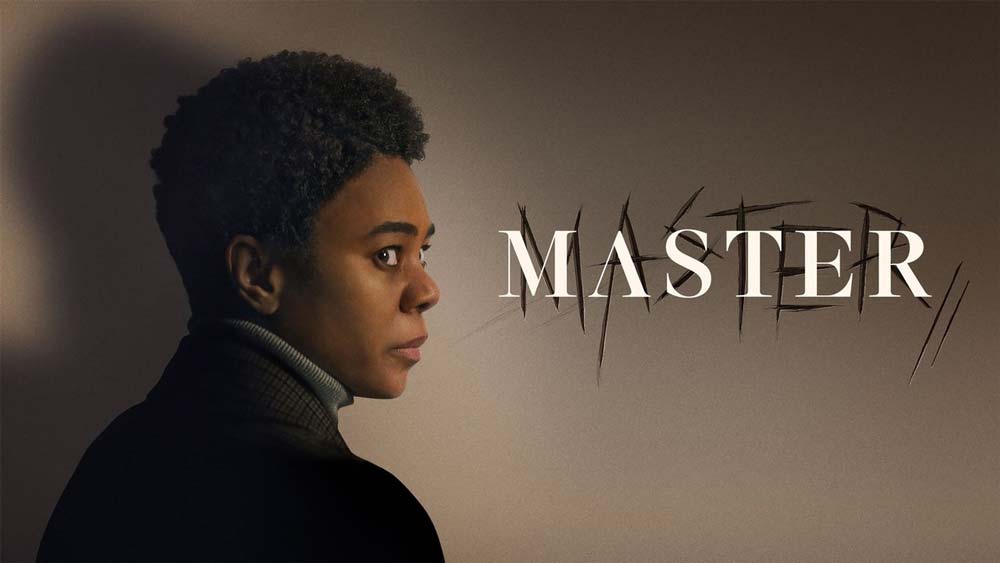*
5D writer Laurie S. Bachman provides her thoughts on this psychological rollercoaster
*
Regina Hall, my new girl crush and absolute bomb legend in the making. This week I was treated to the theatrical creation of Master – the Amazon original movie, currently available on Prime. I am going to start of by saying it was intense, stark and mystifying. Leaving me with the distinct feeling that I had watched something uncomfortable unfold before me. The reason for this discomfort was not dislike of the movie, but because it showcased so much more than a gothic horror retelling.
*
Master opens with Regina Hall entering the hallowed halls of a prestigious Ivy league American College, this is juxtaposed with a young black woman starting out their academic journey (Zoe Renee).
*
As a white woman, it felt uncomfortable for me in parts. This is in no way in relation to the story telling, the plot or the scenes of psychological terror, as this is a horror movie of a different ilk. Instead, my discomfort derived from the seemingly innocuous comments made by the white members of the cast, for which there were many, and the fumbling’s through social propriety that took place at various social gatherings. The only way to describe this is to highlight othering. Exoticising the POC members of the cast and highlighting the “funk” that can be brought when a person of color joins the party.
*
*
The movie successfully showcases the struggles of generations, even the “woke” in navigating and in some cases blatantly ignoring the racial slights and innuendos made by colleagues and class mates. Subtly, they highlight the key issues and arguments at play in the quest for equality, in particular drawing on the instance of the George Washington University professor who “identified” as a POC, but was in fact whiter than me.
*
There was a mixed reception for this film, many chose to focus on the Horror elements at play, the use of the gothic horror format was well done, the “shock” scenes, the use of urban legend and fetishizing of the past were employed. The ghostly instances were few and when looking at this movie as just a horror, one would score it low. The “jump” scenes were predicatable, the tension was not always there.
But, if we look at this as a metaphor for the larger message, then the discomfort and tensions are expertly built, the real horror was not in the scenes but rather in the experiences of these three women.
*
*
Regina Hall held the highest position within her Clique, yet there was little to no respect shown by her fellows. She was routinely down played, when she begins highlighting the issues she is having with the house, the ghostly apparitions, the moving of objects are all dismissed. The references made to her throughout highlight the “image” of having a black woman in the seat. This is evidenced in the scene rehearsing her speech, where she was routinely prompted to emphasize her status as a “Woman of Color”. Regina Hall was brilliant in this movie, long gone are the days of Scary Movie and she shone here as a powerful presence on the screen.
*
The scene in the library, Zoe Renee is checking out books from the college library, when the theft alarms go off. There is the visible discomfort of the woman asking to check her bag. It was uncomfortable to watch, but that is what this movie does. It highlights the issues that are rife with image vs substance, stereotypes and, lets face it the everyday struggles that POC are attempting to highlight to us. Zoe Renee again delivers, in the comparison of grades following the “analysis of representation in the scarlet letter” a mediocre response that highlights the use of sterotypes being graded higher than Zoe’s, when in fact she offers the stronger insight into the analysis of sex and gender representation.
*
*
Finally, we look at Amber Gray and her portrayal of Liv Beckman. The longstanding Woman of Color at Northeastern University, she teaches POC representation. The motif of Gothic Horror is showcased here of how the past is never buried and haunts an individual as they run from it, rather than embrace it. It is revealed that she is in fact white, with no Black heritage to speak of – this is not confirmed in the movie. There is a confrontation between Amber and Regina, where Amber’scharacter highlights the struggles of women of color but also touches upon the struggles of those who are biracial, and the question of “where do I fit?” “Am I black enough?”
It played well on the story that broke in 2020 of the George Washingtonuniversity professor, who had taught black history and had been making waves with the quest for civil rights of the black community, who had it turned out, had been misleading with their heritage and had chosen to identify as black.
*
Was a horror movie right for this message, absolutely. Horror is all about building tension – it plays well on the social tensions and discomforts felt by many. The use of color – red being the predominant indicator of ghostly interactions, white to highlight the less than pure intentions of the fellow cast mates were evident throughout, also used to create the undertones of racism and the Klu Klux Klan. There is a clear ghostly element at play – the use of the slave and the girl that had killed herself all fit the tropes. The sinister nature of those around Zoe Renee and their psychological abuse with the urban legend all do well to create clear tension throughout.
*
Final thoughts, it’s a great movie. There is throughout a psychological rollercoaster, it takes you on a mad ride through the ghosts that haunt Northeastern University. There are thrills and chills, but the most horrifying elements of this tale aren’t those buried in the past, but rather the chilling voices of those trying to be heard in the present.
*


